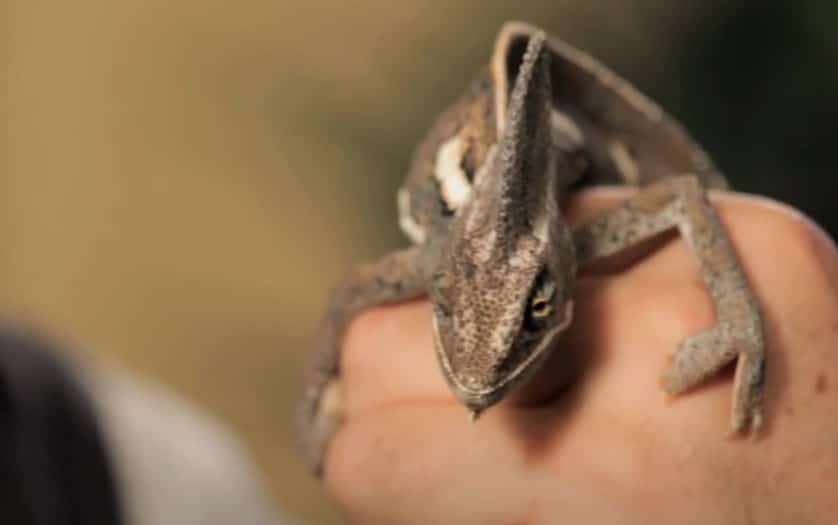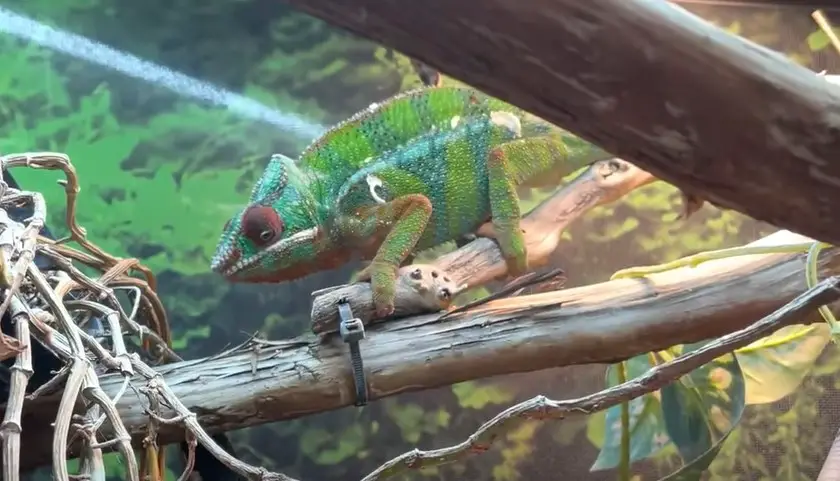Are you concerned about your chameleon not being able to walk anymore?
What happened to cause this and how can you assist?
In this article, we’ll discuss the topic of why your chameleon can’t walk.
Why Can’t My Chameleon Walk?
A pinched nerve, an injury from a fall, impacted stool or MBD (metabolic bone disease) are possible reasons why your chameleon can’t walk. If symptoms include sunken eyes, dull coloration or swelling, please seek a vet’s help right away.

Otherwise, wait 24 hours to notice improvement.
Why Is My Chameleon Having A Hard Time Walking?
Sadly, there are diseases such as MBD (metabolic bone disease) that affect many chameleons more often in captivity than in the wild. MBD can affect your chameleon’s movement and ability to walk or grip onto branches successfully.
You may also notice:
- A lack of appetite
- Dull color
- Sunken eyes
- Swelling of the face
- Trembling legs
A lack of calcium could be the case, but if the disease has advanced, their bones may become brittle and easy to fracture.
It’s important to get a diagnosis if you notice your chameleon not walking for a duration over a 1-2 days.
Why Is My Chameleon Limping?
There may have been an accident in the enclosure that you didn’t notice. An injury to your chameleon can leave it immobile or cause limping.
This limping may end on its own or could continue and worsen over the next few days. Continue to monitor your reptile and make sure that your chameleon is still eating and hydrating.
If you notice bloodshot eyes, sunken eyes, loss of color or other abnormalities, please take your chameleon to the vet for a check-up and diagnosis.
X-rays and a calcium level test may need to be performed.
Why Are My Chameleon’s Back Legs Not Working?
A chameleon may become lethargic or stop walking when there is an issue with its back legs. Paralysis could be temporary or lead to permanent immobility if left untreated.
Possible reasons include:
- a fall has occurred
- pinched nerve
- impaction of stool (chameleon constipation)
- MBD (metabolic bone disease)
Time will tell or a check-up from your chameleon’s vet will help to diagnose the issue before it gets worse. If impaction is the case, gently mist the legs and anus with warm water throughout the day to help encourage a bowel movement.
Why Is My Chameleon Wobbly?
A insufficient amount of UVB light from above the enclosure could affect the balance of your chameleon. We also need to give our chameleons enough calcium and vitamins through gut loading their live food or dusting supplement powders on top of their meals at least 2-4 times a month.
Once your chameleon starts to feel wobbly, it may choose to stop walking. Lethargy, poor appetite and other unwanted symptoms including a dull appearance may start to reveal themselves.
Continue to observe for natural improvement and seek medical help from a vet if this continues past 24-48 hours.
Why Is My Chameleon Walking Funny?
Chameleons have a unique way of walking with caution and care. It may look:
- hesitant
- jerky
- slow
- wobbly
A chameleon’s gait may look silly at times, but it helps them to blend in with the way leaves move naturally when the wind blows.
Along with their color blends, chameleons practically disappear even through they are moving with their surrounding nature.
This type of movement continues in captivity and what you are seeing is funny, but absolutely normal.
Why Do Chameleons Hesitate When They Walk?
Sometimes it seems like forever for your chameleon to take its next step. They freeze and hold or hesitate when walking.
This is a form protection from predators and a natural way of blending in with branches that sway with the breeze.
They also hesitate when hunting. Being able to blend in with leaves and branches, allows them to snatch their prey who don’t suspect a thing and cannot react in time to escape.
Once your chameleon grips onto its prey or catches it with its tongue, it’s a successful hunt.
Did you know that chameleons are the only animals that have horizontal feet? This is a unique and funny way to walk in order to live an arboreal life on branches while moving easily over them.
Can Chameleons Run?
Your chameleon is able to run, but prefers not to. They don’t run fast and are considered slower than most reptiles.
Running is the last resort after their camouflage and hesitant walking strategies have failed them. Blending in would be much easier than trying to run away.

Why Is My Chameleon Shaking When Walking?
Your chameleon may stop walking, shake or become hesitant when you are around. Your large appearance could make your chameleon nervous.
The first reaction is to freeze and stay put until you leave. This is the first line of defense.
If your chameleon is shaking or trembling, the fear response is not as prevalent as a calcium deficiency or the possibility of MBD (metabolic bone disease).
If this shaking persists, it’s best for your chameleon to see a vet.
Conclusion
Chameleons walk strange for a reason. They blend in with the swaying branches and rustling leaves. They may stop walking altogether to freeze when they see you.
Once you leave the room, they might continue walking again. Leave a camera on and test this theory. You might need to build more trust with your chameleon.
If you notice other negative symptoms with dull colors, sunken eyes, refusal of food or shaking when walking, there could be a deeper issue that your chameleon’s vet needs to address.

